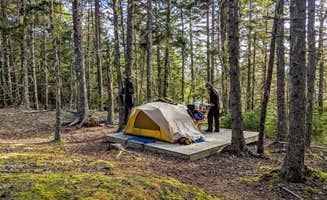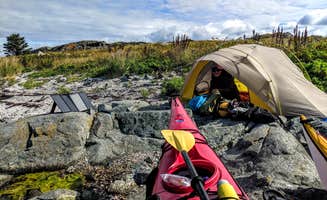The Frankfort, Maine area provides access to island camping sites across the Deer Isle Archipelago, where boat-in dispersed camping offers a true wilderness experience. These islands lie within the protected waters of Penobscot Bay, where average summer water temperatures reach approximately 60°F. Campers must bring all supplies and remove all waste, as these remote camping locations have minimal infrastructure.
What to do
Kayak expedition planning: For free camping near Frankfort, Maine, paddlers should prepare for varying landing conditions on islands like Buckle Island. "This is a perfect island for those new to sea kayak camping as the sandy shore, which is exposed for a good portion of the day, is easy to land on and a short walk to a trail into the woods," notes reviewer Shari G. about Buckle Island.
Beach combing: Marshall Island features unique shoreline exploring opportunities with distinct geological formations. "Sand Cove is perfect for a beach fire and stargazing on a clear night– some of the best stargazing spots we've ever seen!" reports one camper about Marshall Island, highlighting the accessible beach areas.
Wildlife observation: The Deer Isle Archipelago serves as habitat for coastal bird species, seals, and marine life. Doliver Island provides observation points for viewing nearby Isle au Haut. According to reviews, visitors enjoy the "Gorgeous shell covered beach and a beautiful view of Isle au Haut, just next door."
What campers like
Natural isolation: The remote nature of these boat-access only campsites provides exceptional solitude. A review for Wheat Island states camping areas offer "a gorgeous view of the sun setting and full moon rising," making it ideal for those seeking peaceful waterfront sites.
Accessible adventure: Despite requiring water transportation, some islands provide relatively manageable camping for those with basic paddling skills. Buckle Island earns praise as "perfect for those new to sea kayak camping" with its approachable landing areas during lower tides.
Strategic positioning: These islands serve as waypoints for multi-day paddling trips. Doliver Island received this practical assessment: "a good stop for us on our 9 day journey and a perfect launching spot for crossing Jericho Bay (4.5 miles) to Marshall Island the next day."
What you should know
Limited facilities: These dispersed camping locations provide no amenities. One reviewer notes about Marshall Island, "Come prepared with fresh water (there is no fresh water for filtering) and wag bags (no toilets)."
Membership requirement: Access to these camping areas requires Maine Island Trail Association (MITA) membership. As one camper states about Wheat Island, "Sites are first come, first served and completely free for MITA members."
Insect awareness: Mosquitoes remain active through early fall. A visitor to Doliver Island reports: "We thought we were passed mosquito season in early September, but alas, they were pretty bad all day long."
Tidal landing challenges: Water access points change significantly with tide levels. One Wheat Island visitor cautions, "This can be a tricky island to land on at high tide, so plan accordingly."
Tips for camping with families
Space considerations: Select islands with adequate camping areas for group setups. Marshall Island offers larger sites with helpful infrastructure: "We stayed at one of the 2 sites near Sand Cove which is a truly gorgeous wooded area with a tent platform and a picnic table at each site."
Emergency planning: Families should establish communication and evacuation plans before departure. Having marine radios and weather monitoring capabilities remains essential, as cell service is unreliable across most islands.
Resupply options: For extended stays, know nearby resupply points. According to one Marshall Island visitor, "If you happen to need a food or water resupply, Swan's Island is a short paddle away and has a very small grocery store and town office with fresh water."
Tips from RVers
Mainland parking security: When accessing boat-in sites, secure parking for vehicles and trailers remains limited near water access points. Advance research for overnight parking regulations at public boat launches is necessary.
Storage considerations: Weather-proof storage containers for camping gear transfer between vehicle and watercraft provide protection from salt water exposure. Specialized dry bags rated for marine environments offer superior protection compared to standard camping storage.
Launch site selection: Choose boat launches based on paddling distance and skill level. The islands in this archipelago range from 1 to 5 miles offshore, requiring varying levels of open-water paddling experience.





